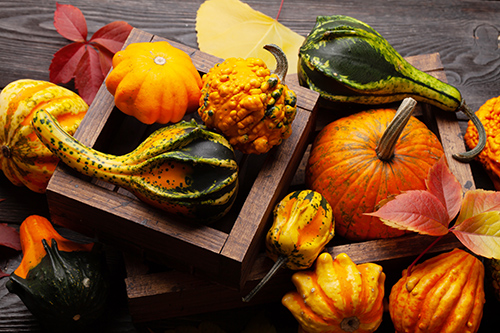Contents
The many health benefits of squash have been known throughout history. The biblical prophet Jonah found shade under the vine of a gourd to relieve his sunstroke. The Romans used this vegetable together with honey to aid the digestion of the prodigious amounts of meat they wolfed down in their orgies. In some Mediterranean regions, certain types of squash, or gourds, are used as bottles once dried. Moreover, in North America, pumpkins are carved with faces to make jack-o’-lanterns at Halloween.
However, these coarse gourds hold a treasure of medicinal properties, which few appreciate even today. The composition of their pulp makes them one of the most beneficial foods available for maintaining healthy arteries, along with many other dietary and therapeutic applications.
Squash Nutritional Facts
The remarkable nutritional value of squash’s reddish pulp is partly due to its composition and what it does not contain. It is among the lowest foods in fat and sodium, both antagonistic to healthy arteries and the heart.
The nutrient content of squash is low: six percent carbohydrates, one percent proteins, and virtually no fat. On the other hand, it stands out for its richness in beta-carotene (provitamin A) and minerals such as potassium and calcium. Its soluble fiber content is also significant, which gives the squash a satiating effect on the appetite.
Despite its low caloric and nutritional content, squash has a certain satiating quality due to its consistency and richness in soluble fiber.
Health Benefits of Squash
All squash varieties have the same hypotensive, diuretic, laxative, and anticarcinogenic properties. As a result, their primary medical uses are:
Hypertension—Squash is remarkable for its incredibly low sodium and exceedingly high potassium content. Sodium-rich diets promote high blood pressure, while a potassium-rich diet prevents hypertension and its negative consequences (arterial blood clots and stroke).
Most of the SODIUM taken daily is from salt added to foods during preparation. However, foods contain various amounts of sodium, contributing to this mineral’s daily intake. The health benefits of squash are appropriate for those with hypertension, not only because of its shallow sodium content but also because of its large amount of potassium.
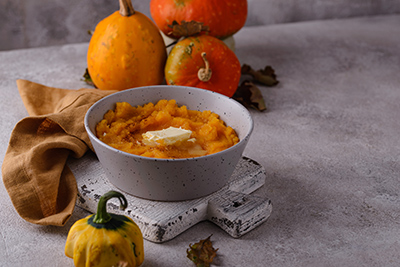
Because of this, squash’s Na/K quotient (sodium/potassium) is among the lowest of any food, which explains its beneficial effect on high blood pressure. People with hypertension may consume squash daily in any form but with no added salt, which would negate its properties. A daylong treatment based on pureed squash is also of great benefit.
Coronary conditions and arteriosclerosis – Because of its minimal levels of fat and sodium and its abundance of beta-carotene (provitamin A), which protects the arteries’ walls, the health benefits of squash are recommended for those who wish to care for their arteries. Those suffering from coronary heart disease (angina pectoris or heart attack) should not fail to consume squash at least three times weekly.
Renal disorders—The health benefits of squash acts as a mild diuretic in the kidneys, increasing urine production and encouraging the elimination of bodily liquids. Its use is beneficial in inflammatory kidney disorders (nephritis, glomerular nephritis), edema (fluid retention), and whenever there is any level of renal failure; in other words, the kidney’s inability to perform its urine production function satisfactorily.
Stomach disorders – Squash pulp can neutralize excess stomach acid because of its richness in alkalizing salts. It also has an emollient and protective effect on the stomach mucosa. Its consumption, particularly pureed with milk or soy beverage, is particularly indicated in cases of excess stomach acid, dyspepsia (indigestion), pyrosis (heartburn), and, of course, issues of gastroduodenal ulcer. In this case, a diet of pureed squash and potatoes with milk is highly effective during the acute phase of the ulcer.
Constipation—Because of its mild laxative effect and soothing action on the digestive tract, the health benefits of squash is suggested for constipation or other intestinal malfunctions marked by excess fermentation or putrefaction. Squash fiber is soluble, acting as a mild laxative and not irritating the intestine.
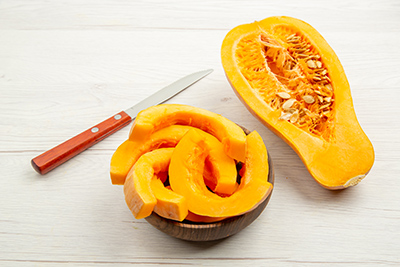
Eye Conditions – The beta-carotene richness of squash makes it a beneficial food in cases of loss of visual acuity or vision disorders in the retina. It is now well known that eating fruits or vegetables rich in BETA-CAROTENE, particularly when they are rich in potassium, as in squash, prevents the formation of cataracts. This was demonstrated in a study at Harvard University, in which women who frequently ate squash, spinach, and sweet potatoes, did not present cataracts.
Cancer prevention—Squash contains the three most effective, proven anticarcinogenic vegetable-based substances: beta-carotene, vitamin C, and fiber. Finding these three highly effective anticarcinogens in one food is difficult. Because of this, the squash family and cabbages constitute the foods with the highest level of anticarcinogenic effect. Neither squash nor cabbage should be absent from the diet of those at increased risk of cancer because of heredity or environmental factors.
Similarly, those diagnosed with and in cancer treatment may benefit from eating more squash. A study carried out at Hyogo College in Japan showed that laboratory rats exposed to carcinogenic substances and then fed on yugao-melon, a type of crook-necked squash, presented half the cases of colon cancer as those that had followed a regular diet. This experiment again shows the capacity of certain plant-based foods, such as squash, to neutralize the effect of carcinogens.
Squash Scientific Facts
- Scientific name: Cucurbita pepo L.
- Related species: Cucurbita maxima L.
- Other names: Pumpkin, Courge, Calabaza, Coyote melon, Gourd.
- French: Courge.
- Spanish: Calabaza, Zapallo, Chayote.
- German: Kürbis.
- Description: These are the fruits of various vines of the botanical family Cucurbitaceae. Squash has multiple shapes: spherical, flattened, elliptical, and bottle-shaped. Their rinds vary in color from orange, yellow, green, white, black, or even purple. Their pulp or flesh is orange or yellow; the center area is filled with seeds.
- Environment: They grow in hot, humid regions throughout the world.
Squash Seeds
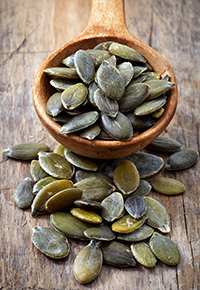
Squash seeds may be eaten raw or lightly toasted. These seeds and the oil extracted are rich in linolenic acid, zinc, iron, and vitamin E. However, the most exciting aspect of squash seeds is their cucurbitacin or cucurbitin, an active alkaloid-type element. This substance is responsible for the many health benefits of squash.
- Antiprostatic—Squash seeds prevent prostatic hypertrophy (excessive growth), which is produced in many males over the age of fifty. They also reduce inflammation and relax the urinary bladder, facilitating urination.
- Vermifuge—Squash seeds paralyze parasitic worms in the intestine, such as tenia (tapeworm) and Ascaris. Once immobilized and released from the intestinal wall, they are expelled using a laxative. The details of using squash seeds as an intestinal antiparasitic treatment are explained in more depth here!
Squash Blossoms
Squash blossoms are highly prized in Mexico, where they are used to make delicious “quesadillas” based on cheese and squash blossoms wrapped in a corn tortilla. Because of their delicate flavor, squash blossoms are also used in various vegetable dishes.
From a nutritional standpoint, squash blossoms provide vegetable fiber and a small number of carbohydrates. However, they are particularly rich in beta-carotene and flavonoids, which are potent antioxidants and perform essential functions in preventing arteriosclerosis and cancer.
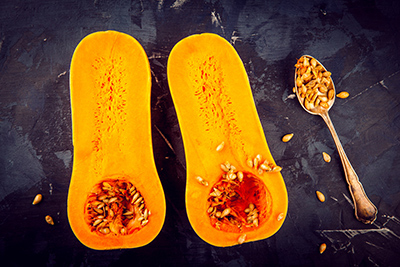
How to use and Prepare Squash
- Baked – The squash is cut in half or into various pieces and baked in the oven until golden brown. It is eaten with honey or combined with fruit.
- Cooked – Squash is used in soups and stews.
- Puree – After cooking, blend the squash with milk or soy. It may be sweetened to taste, preferably with honey.
Preparing Squash for Cooking
- After cutting the squash into appropriately sized sections with a large knife, remove the seeds and fibrous interior with a spoon.
- Remove the rind.
- Cut into pieces according to the culinary need.
DISCLAIMER: All content on this website is presented solely for educational and informational objectives. Do not rely on the information provided as a replacement for advice, diagnosis, or treatment from a qualified medical expert. If you are pregnant, nursing, or have any preexisting medical concerns, talk to your doctor before using any herbal or natural medicines.
REFERENCES
- George D. Pamplona-Roger, M.D. “Encyclopedia of Foods and Their Healing Power.” George D. Pamplona-Roger, M.D. Encyclopedia of Foods and Their Healing Power. Trans. Annette Melgosa. Vol. 2. Chai Wan: Editorial Safeliz, 2005. 97, 98, 99, 100. Print.
- The Journal of Nutrition: https://academic.oup.com/jn
- National Institutes of Health (National Eye Institute): https://www.nei.nih.gov/
- American Diabetes Association: https://diabetes.org/
- Nutrients: https://www.mdpi.com/journal/nutrients

